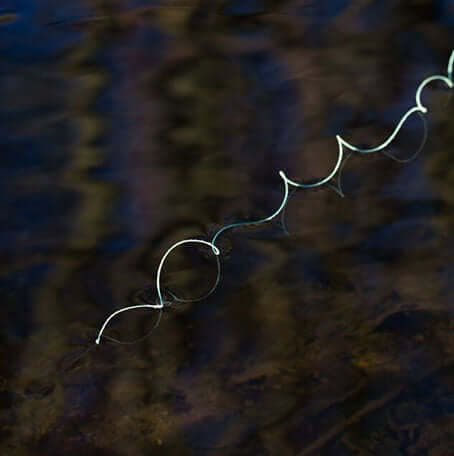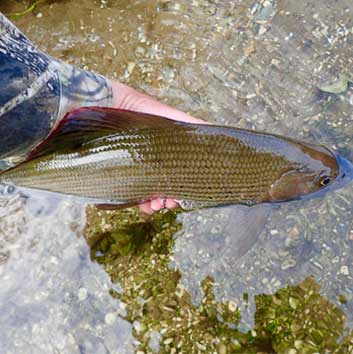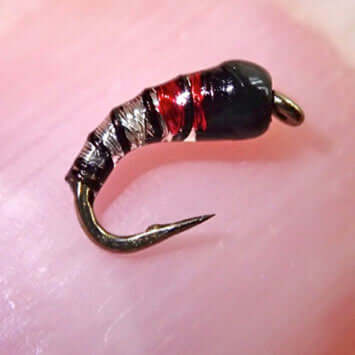Over my nearly 60 years of fishing I’ve come across many situations where the fish have been very challenging to catch because they have become highly educated by heavy fishing pressure & frequent recapture. This is inevitable with an increasing number of fly fishers releasing all the fish that they catch.
I well remember the late 1960s & early 1970s when the upsurge in carp fishing thanks to Richard Walker’s exploits & writings generated incredible pressure on some carp lakes. Baits such as boiled potatoes & the like became less & less effective as the fish began to associate them with the unpleasantness of being captured. As a result anglers experimented with a wide range of alternatives. Particle baits such as sweet corn became very popular because the fish took much longer to associate them with danger as there were many free samples thrown into the lakes, with no hook attached, so the ratio of pleasant experiences to unpleasant ones was very high. Then Fred Wilton invented the Boillie, a bait resistant to the attentions of small fish that could be made in a wide range of flavours & colours. Look in any coarse fishing shop these days & you’ll see a mind-blowing array of baits & flavourings available to the carp fisher. Furthermore tactics have evolved to present these baits in such a way that they behave naturally & do not arouse the suspicion of a feeding fish.
So how does all this have any relevance to us fly fishers? Well trout & grayling are no different from those carp. If you keep catching them on the same flies, with the same tactics then they will soon learn to associate them with danger & will avoid them. My local small still water is a prime example of a heavily fished lake where virtually all fish are returned. Furthermore it is only stocked infrequently (about four times a year). It was heavily stocked recently & for the first couple of weeks the fish were suicidal with catches of over a hundred fish being recorded. At the time of writing, six weeks later, catches are averaging two or three fish a session. No longer will the rainbows take what ever is offered, however it is presented. Brightly coloured Blobs & assorted Lures that produced prodigious numbers of fish when they were first stocked, now produce virtually no response other than fear. Some of us are still catching over twenty fish in a five hour session by ringing the changes & ensuring that our presentation is as far as possible flawless.
So what changes & what presentations are needed to cope with educated trout & grayling? Let’s deal with fly choice first. In my opinion, far & away the best fly choice for highly educated fish is to fish imitative patterns that represent the natural food items that the fish regularly feed on. These do not have to be exact imitations but must be the right size & profile, plus sometimes the right colour. On my local small still water the rainbows feed mainly on tiny Chironomid midges (larvae, pupae & adults) & a size 20 Bloodworm, size 24 Buzzer Pupa or size 24 or smaller CdC Midge or Griffiths Gnat will rarely be refused as long as it is presented properly. An alternative that can work is to use a non-imitative attracter pattern that the fish have never seen before, in some cases an old familiar pattern but in a different colour. Again on my local still water the fish at the time of writing will rarely take a Bloodworm or Squirmy Worm that is red or pink, but a Luminous Green one will produce a few fish. On the heavily fished section of Pickering Beck a Gold Bead Nymph is far less effective than one with a black bead because the fish have seen a lot of gold beads, whilst on the very lightly fished sections of the beck a Gold Bead Nymph will outfish one with a black bead.
In many cases even more important than fly choice is presentation. It is very difficult to get a fly to behave naturally when it is tethered to a length of nylon & a fly line & often to tempt educated fish requires a natural presentation. This problem is exacerbated when fishing with very small flies (size 20 to 30), which is something that I often do when fishing for heavily pressured fish. So what can we do to reduce & delay drag?
- The simplest way, if fishing with a dry fly, is to fish at very close range using a long light rod, with all the fly line & as much of the leader as possible held off the water surface so that rogue surface currents can not pull the fly off course. Similarly, if nymphing, ideally hold all the line/leader & any indicator off the surface so that the faster surface flow has the minimum impact on the speed of sinking & the speed of drift of the nymph(s); this is the essence of Euro nymphing. Fixed-line Tenkara fishing with a line plus tippet not much longer than the rod is ideal for this as long as the fish aren’t too big.
If you have no choice but to fish at such a distance that leader & line have to lay on the river’s surface then there are several ways to control the onset of drag.
- Use long flexible leaders & in particular long tippets (as long as you can manage comfortably) so that they can easily respond to vagaries of the current without pulling on the fly/flies. I usually fish with leaders plus tippet from 12’ to 18’.
- Use suitable slack-line casts such as Reach Casts, Parachute Casts & Wiggle Casts.
- Drag can only set in once the tippet, leader & line have come into contact with complex surface currents, so use fly-first casting techniques such that the fly lands on the water before the leader & line. Tenkara & the Italian Style of Casting aim to do this.
- Mend the line when necessary (flick it to redirect it such that the effects of any rogue current are compensated for). A well greased, light line & long rod are a considerable help when mending.
- Don’t try to achieve too long a drift.
If you want to eliminate drag completely then the answer is pinpoint casting, landing the fly on a fish’s nose, or if the fly has a bit of weight then on the fish’s tail, so fish reacts instantly & takes before there is time for any drag to set in. I used this tactic very successfully on my local small still water a few days before writing this. The rainbows were rising vigorously to a hatch of tiny Chironomid midges at the inlet stream area where there are complex surface flows. Within a second my size 26 CdC Midge was starting to drag despite using 6 feet/2metres of 0.09mm tippet & another 10 feet/3 metres of tapered leader. However by landing my fly on the noses of visible rising fish I tempted half a dozen before the shoal spooked.
Educated fish can often be very tolerant of people, unlike most wild fish that usually spook at the least provocation & this can be to the angler’s advantage. I remember well a visit to an easily accessible stretch of Yellowstone’s Soda Butte Creek after the wild cutthroat trout in September 2009. A guide & his two clients had just fished through a pool ahead of me with no success, so I was a bit apprehensive about how I might do. I need not have worried. The shoal of a dozen or more cutthroats showed no sign of distress at my presence, continuing to rise to a mixed hatch of small upwings & a fall of ants within a mere two rods lengths of me as I waded slowly up the pool. This allowed me to ‘high stick’ with a 10’ rod & just my 12’ leader & 2’ of line outside the rod top. Using these tactics I could cast very accurately to feeding fish, whilst ensuring that there was virtually no drag as only my dry fly & a few inches of tippet were on the water’s surface. The result was half a dozen lovely fish from 12 to 16 inches long.
An example of a situation when I had to use a radical approach re fly choice & presentation was when in September of 2017 I fished a small, gin-clear Austrian lake that had obviously seen a lot of fishing pressure over the preceding months. The brown trout & brook trout would look at a range of dry flies but not take them, even size 24 CdC midges & a similar response was observed when I changed to various nymphs. They showed more interest when in desperation I changed to a Pink Squirmy Worm which they would shoot across to investigate & follow right down to the lake bed. I finally discovered that if I left my Squirmy static on the lake bed the fish would return several times to check it out & finally they’d inhale it. This tactic produced half a dozen fish in half an hour after an hour of unsuccessful fishing.

1. A big grayling from a heavily fished water that succumbed to a realistic size 20
Bloodworm

2. Soda Butte Creek Cutthroat trout that demanded perfectly drag-free
presentation

3. Well educated Austrian Lake brown trout that would only take a
pink Squirmy Worm fished static on the lake bed

4. Austrian Lake Brook Trout that refused everything except a Pink Squirmy
Worm fished static on the lake bed
































